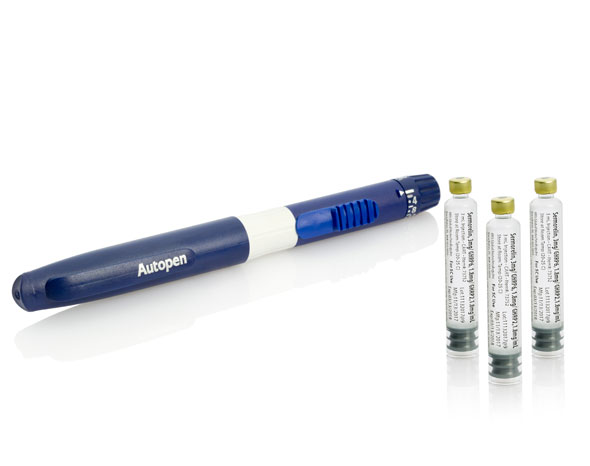- Home
- Growth Hormone
- Growth Hormone
- Growth Hormone Deficiency
- Growth Hormone Therapy
- Growth Hormone Injections
get startedThe Most Effective Hormone Replacement Therapies- General Info
- Uses for Sermorelin
- Dosage and Administration
- Benefits
- Side Effects
- Warnings
- Where to Get
- Reviews
What Is Sermorelin? Understanding Sermorelin’s Uses, Doses, and Side Effects
Sermorelin (Sermorelin-acetate) is a synthetic version of a substance naturally produced by your body known as a human growth hormone-releasing hormone, or growth hormone releasing factor (GHRH or GHRF). Sermorelin belongs to a class of biochemical compounds called secretagogues, that is; these are agents that are not necessarily active agents themselves. Instead, secretagogues can result in the release (secretion) of other agents or hormones which can then exert their effects on the body. GHRFs like sermorelin stimulate the release of growth hormone from the pituitary gland.
In children who fail to grow normally because their bodies are not producing enough growth hormone, or for adults that are also exhibiting signs and symptoms of growth hormone deficiency, sermorelin therapy can be an effective treatment.
According to the prescribing information, “Sermorelin is a sterile, non-pyrogenic, lyophilized powder intended for subcutaneous injection after reconstitution with Sodium Chloride Injection, USP.”
Sermorelin is an injectable prescription medication that can be used alone, or in combination with growth hormone injections to treat children or adults with growth hormone deficiencies. Sermorelin is only available with a doctor’s prescription.
Sermorelin is available in vials. The quantitative composition per vial is:
- 0.5 mg vial: Each vial contains 0.5 mg sermorelin (as the acetate) and 5 mg mannitol. The pH is adjusted with dibasic sodium phosphate and monobasic sodium phosphate buffer.
- 3.0 mg vial: Each vial contains 3.0 mg sermorelin (as the acetate) and 5 mg mannitol. The pH is adjusted with dibasic sodium phosphate and monobasic sodium phosphate buffer.
A dosage of 0.2 – 0.3 micrograms (mcg) once daily at bedtime by subcutaneous injection is recommended. It is also recommended that subcutaneous injection sites be periodically rotated.
How to administer sermorelin:
To prevent possible contamination, wipe the rubber vial stopper with an antiseptic solution before puncturing it with the needle. It is recommended that Sermorelin be administered using sterile, disposable syringes and needles.
Note: If you are self-injecting your prescribed dose of sermorelin, it is critically important that you use it exactly as directed by your physician or healthcare provider. Using more or less than your prescribed dose can result in ineffective treatments, or increase the risk of unwelcome side effects.
Sermorelin acetate for injection increases plasma growth hormone (GH) concentration by stimulating the pituitary gland to release GH. Sermorelin is similar to the native hormone (GRF [1-44]-NH 2) in its ability to stimulate HGH secretion in humans.
The benefits of increased secretion of HGH include:
- Skeletal Growth
- Increased bone density
- Cell Growth
- Organ Growth
- Increased protein metabolism
- Improved carbohydrate metabolism
- Improved Lipid Metabolism/Reduction of Body Fat
- Improve your ability to burn fat
- Promote weight loss
- Improved Mineral Metabolism – particularly resulting in an increase in bodily potassium and phosphorus levels
- Improved tissue metabolism – particularly an increase in collagen production
- Improved heart health / reduce cardiovascular risks
- Increased lean muscle and strength
- Improve your libido / erectile dysfunction and sexual performance
- Strengthen the immune system
- Increased energy and stamina
- Improved sleep
- Improve cognition and memory
- Better fracture healing
Sermorelin injections are approved by the FDA and are generally regarded as safe. However, as with any prescription medication, there are some potential side effects of sermorelin therapy.
The most common side effects of sermorelin injections are pain, swelling or redness at the injection site.
Other side effects may include:
- Headache
- Flushing
- Difficulty swallowing (dysphagia)
- Dizziness
- Hyperactivity
- Drowsiness
- Rash or hives
See your medication’s insert for a complete list of potential side-effects.
Your prescription for sermorelin will be tailored to best meet your particular goals and lifestyle. You will be carefully monitored over the course of your treatment with sermorelin, so any chance of side effects should be kept to a minimum. Tell your doctor if you are experiencing any of these or other side effects while taking sermorelin.
The only contraindication listed in the prescribing information for sermorelin use is that concomitant glucocorticoid therapy may inhibit the response to sermorelin.
There are no other particular warnings associated with sermorelin use.
There have been no reports of dependency with sermorelin, and the clinical pharmacology suggests that sermorelin is very unlikely to be associated with drug abuse
You should get your prescription for sermorelin injections from a reputable doctor or clinic that specializes in hormone replacement therapies (HRT) for men and women.
This way you can be sure that all of your levels of your critical hormones, including growth hormone and testosterone will be evaluated, and the right treatments, including sermorelin therapy will be prescribed to suit your unique needs, symptoms, goals and lifestyle
As a woman who used Sermorelin, I experienced noticeable improvements in energy, sleep quality, and overall well-being. It's been a positive addition to my health regimen
EvangeleneVerified - Growth Hormone Therapy







